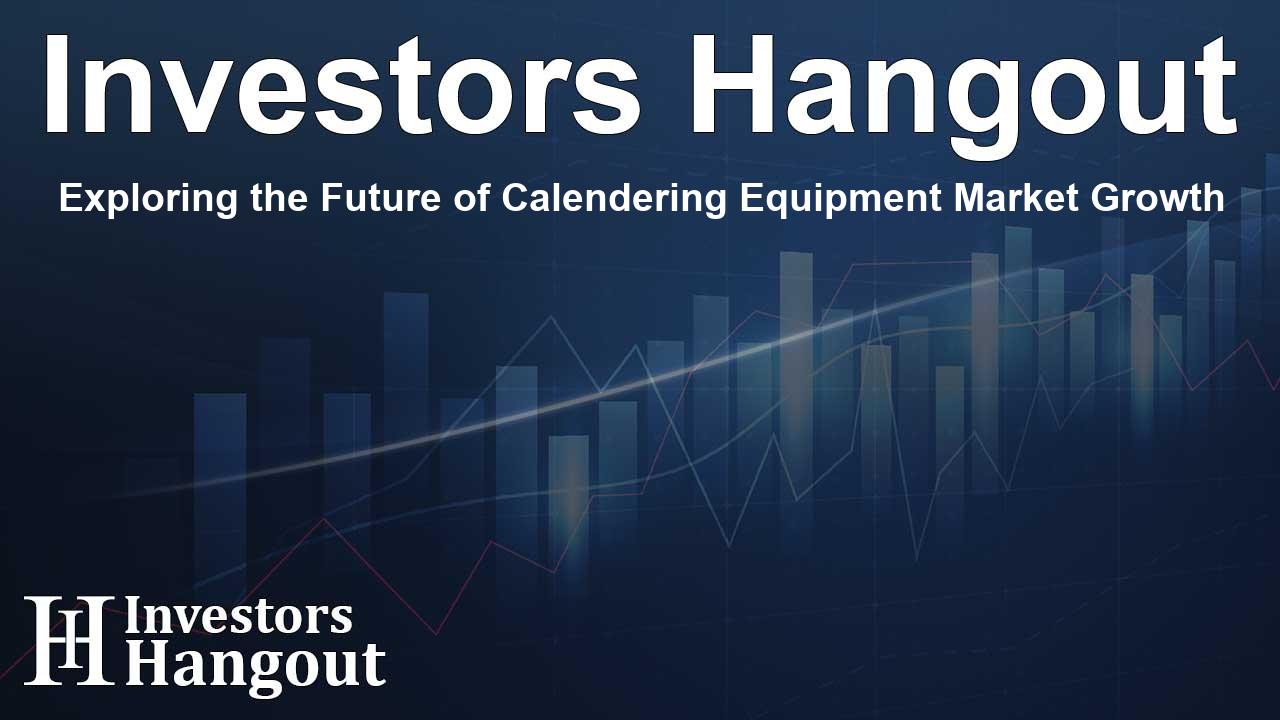Exploring the Future of Calendering Equipment Market Growth

Understanding the Growth of the Calendering Equipment Market
The calendering equipment market is on a remarkable trajectory, anticipating a significant rise in value from USD 8,679.80 million in 2024 to USD 16,293.10 million by 2034. This expansion, which represents a Compound Annual Growth Rate (CAGR) of 6.50%, can be attributed to several driving factors.
Key Drivers Behind Market Expansion
The surge in the calendering equipment market is primarily fueled by the growing demand for calendered materials, as well as technological advancements that enhance operational efficiency. Manufacturers are increasingly turning to automatic calendering systems that not only streamline production but also significantly lower energy costs.
Technological Innovations
Automatic calendering technologies are at the forefront of this growth. By improving energy efficiency, these innovations attract manufacturers looking to reduce their operational expenses while maintaining high-quality outputs. Furthermore, the focus on sustainable practices has manufacturers seeking eco-friendly solutions that meet consumer demands.
Broader Application Landscape
As diverse industries continue to require more high-quality, consistent materials, the range of applications for calendered products expands. This broader applicability creates a robust environment for market growth, appealing to various sectors including textiles, rubber, and plastics.
Challenges in the Calendering Equipment Market
Despite the positive outlook, challenges remain that could impact market dynamics. High initial investment costs for advanced equipment can deter smaller manufacturers from entering the market. Additionally, the need for specialized maintenance due to advanced technological systems can inflate operational costs.
Adapting to Technological Changes
The fast pace of technological advancement poses another challenge. Manufacturers must continuously upgrade their equipment to stay competitive, leading to potential obsolescence of existing machinery. This situation often creates financial strain, especially for smaller players in the market.
Market Segmentation Insights
The calendering equipment market is diversified into several segments, based on technology type, end-use industry, and region. Understanding these segments can provide valuable insights for stakeholders looking to navigate this evolving landscape.
- By Technology Type: Includes Two-Roll, Three-Roll, Four-Roll, and Multi-Roll Calendering.
- By End-Use Industry: Encompasses Paper & Printing, Rubber & Plastic, Battery Production, Textile, and other sectors.
- By Region: Spanning North America, Latin America, Europe, East Asia, South Asia, Oceania, and the Middle East and Africa.
Regional Insights into Market Activity
Regionally, the calendering equipment market shows varied growth prospects. For instance, the market in the United Kingdom is predicted to grow at a CAGR of 5.00% by 2034, driven by steady demand in traditional sectors like packaging and printing. However, fluctuations in economic conditions and the maturity of these sectors may pose limitations.
Innovation in Specialized Applications
As industries adopt modern manufacturing techniques, there is a recognized need for customized calendering solutions. This customization can cater to specific application needs, enhancing efficiency and potentially revealing new niche markets. Therefore, while challenges exist, opportunities also emerge for those willing to innovate and adapt.
Impact of Consumer Demand
Today’s consumers are influencing manufacturing processes by demanding greener practices. Thus, the calendering equipment market is witnessing a shift toward energy-efficient and environmentally sustainable production methods, aligning with the modern consumer's expectations.
Conclusion: A Promising Future for Calendering Equipment
The future looks bright for the calendering equipment market as it gears up for robust growth, driven by automation, energy efficiency, and expanding applications. Companies that embrace these innovations and adapt to challenges will likely find themselves at the forefront of a flourishing industry.
Frequently Asked Questions
What is the projected growth of the calendering equipment market?
The market is expected to grow from USD 8,679.80 million in 2024 to USD 16,293.10 million by 2034, achieving a CAGR of 6.50%.
What factors are driving this market growth?
Key drivers include advancements in automatic calendering technologies, increased applications for calendered materials, and a focus on energy efficiency.
What are the main challenges facing the calendering equipment market?
Challenges include high initial investment costs, the need for specialized maintenance, and the risk of technological obsolescence.
How is the market segmented?
The market is segmented by technology type, end-use industry, and region, allowing for a detailed analysis of various market dynamics.
What is the significance of consumer demand in this market?
Growing consumer demand for eco-friendly and sustainable practices is driving manufacturers to adopt greener production methods, influencing market trends significantly.
About Investors Hangout
Investors Hangout is a leading online stock forum for financial discussion and learning, offering a wide range of free tools and resources. It draws in traders of all levels, who exchange market knowledge, investigate trading tactics, and keep an eye on industry developments in real time. Featuring financial articles, stock message boards, quotes, charts, company profiles, and live news updates. Through cooperative learning and a wealth of informational resources, it helps users from novices creating their first portfolios to experts honing their techniques. Join Investors Hangout today: https://investorshangout.com/
Disclaimer: The content of this article is solely for general informational purposes only; it does not represent legal, financial, or investment advice. Investors Hangout does not offer financial advice; the author is not a licensed financial advisor. Consult a qualified advisor before making any financial or investment decisions based on this article. The author's interpretation of publicly available data shapes the opinions presented here; as a result, they should not be taken as advice to purchase, sell, or hold any securities mentioned or any other investments. The author does not guarantee the accuracy, completeness, or timeliness of any material, providing it "as is." Information and market conditions may change; past performance is not indicative of future outcomes. If any of the material offered here is inaccurate, please contact us for corrections.